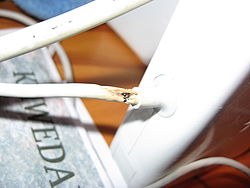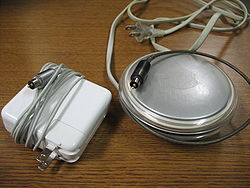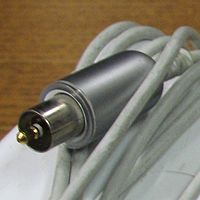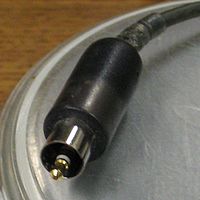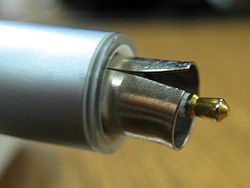- MagSafe
-
MagSafe 
The (original) MagSafe power adapter on a MacBook.Type Computer power connector Production history Manufacturer Apple Inc. Produced 2006 Superseded Apple Power Connector General specifications Hot pluggable Yes External Yes Pins 5 Pin out 
Male connector, front view Pin 1 Ground Pin 2 V+ @ 16.5 VDC Pin 3 Charge control pin Pin 4 V+ @ 16.5 VDC Pin 5 Ground Grey area indicates magnetic connector MagSafe is a proprietary magnetically-attached power connector introduced by Apple Inc. on January 10, 2006 in conjunction with the MacBook Pro at the Macworld Expo in San Francisco. The MagSafe connector is held in place by a magnet so that if it is tugged on, for example by someone tripping over the cord, it will pull out of the socket safely, without damaging the connector or the computer power socket, or pulling the computer off of a table or desk.[1] MagSafe is similar to the magnetic power connectors that many deep fryers and Japanese countertop cooking appliances have in order to avoid spilling their dangerously hot contents.[2] Apple exclusively owns US Patent No. 7311526 ("Magnetic connector for electronic device", issued in 2007) and does not license the MagSafe connector or the patent.
Contents
Features
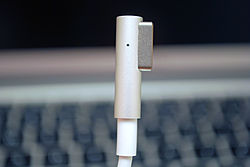 The newer, L-shaped MagSafe Power Adapter that ships with all current MacBook Pro & MacBook Air models.
The newer, L-shaped MagSafe Power Adapter that ships with all current MacBook Pro & MacBook Air models.
MagSafe has connector pins that are designed so the rectangular connector can be inserted in either orientation (however the newer version of the connector can only be fitted in one orientation without blocking neighboring ports, such as USB). LEDs on both sides show green if the computer battery is fully charged and amber or red if the battery is charging. MagSafe can be found on the MacBook, MacBook Pro, and MacBook Air notebook computers, as well as the Apple LED Cinema Display.[3]
The MacBook and the 13" MacBook Pro use a 60 W MagSafe charger, whereas the 15" and 17" MacBook Pro use a 85 W MagSafe charger. Although the 60 W and 85 W MagSafe connectors are identical in appearance, Apple recommends using only the adapter that was provided with the machine. The MacBook Air has a different sized, lower powered 45 W version of the MagSafe adapter. The power brick is smaller, but the MagSafe connector is the same size.
Apple also offers a MagSafe Airline Adapter for use on certain compatible airplanes. It has a DC input (instead of AC like the original MagSafe chargers) and will power the computer, but will not charge the battery.
Pinout
The MagSafe connector pins are palindromic, allowing for the adapter to be inserted in two opposite orientations. The first and second pins on each side of the tiny central pin have continuity with their mirror pins.
- The inner large pins are V+ (16.5 VDC). Measuring with no load will give 6.86 VDC; the full 16.5 V is provided to the proper load.
- The outer large pins are Ground.
- The tiny center pin is a Charge Control pin that assists with changing the LED color, and also assists with switching the adapter off. No power will be outputted from any of the other ports until contact is made with the center Charge Control pin.[4]
The rectangular metal shroud surrounding the pins has no electrical function. Rather it acts as shielding for the electrical pins and a ferrous attractor for the magnet in the laptop.
Criticisms and defects
Although Apple does not license the MagSafe connector for use in third-party products, manufacturers have devised a workaround: their MagSafe items use the actual connector from Apple’s AC adapter, grafted onto their own product. Since this uses an actual Apple product, purchased legally, manufacturers believe that no licensing agreements are needed and the patents are not violated.[5] However, in 2010 Apple still sued one such manufacturer, Sanho Corporation, for selling its very popular HyperMac battery extension products which Apple claimed violated their patents, resulting in Sanho ceasing to sell their connector cable for the Hypermac series of external batteries.[6][7]
Many users have reported (as of October 30, 2011) problems with the quality of the construction of the MagSafe cords, giving the product low marks on the Apple Store’s website.[8] Common complaints include plug separating from the cord, transformer shorting, and pin springs losing elasticity.[9]
Several methods have been devised to protect the MagSafe from failure, including wrapping the cable with tape or sliding protective plastic around the cable.[10]
In 2008, Apple posted an official response acknowledging problems with MagSafe adapters, which include incomplete circuit connection and adapter's white insulation separating from the magnetic end of the MagSafe connector.[11] Following the release of a Knowledge Base article, a class action lawsuit was filed on 2009-05-01 in the California Northern District Court's San Jose office, alleging that the MagSafe power adapter is prone to frayed wires and overheating, and as such represents a fire hazard.[12] Apple has since released a new connector to remedy the defects.[13]
There had been a variety of reports[14] of the newer MagSafe AC adapter not working with older MagSafe-powered MacBooks and MacBook Pros. Apple released a firmware update in October 2010 that it claims resolves this issue.[15] However the installer for the firmware update will not run on certain older MacBooks, which means that the firmware can not be updated. This in turn means that it is not possible to use the new MagSafe power adapter with these MacBooks. Currently it is not possible to buy new replacement MagSafe AC adapters (either from Apple or third-party suppliers) that work with these MacBooks, forcing owners to look for used original adapters.
In 2011, Apple posted a support document regarding the strain relief problems with the MPM-1 ("T") style MagSafe power cables, and issued settlement offer for buyers of Apple 60W or 85W MagSafe MPM-1 adapter within the first 3 years of purchase.[16]
Prior power systems
Close-up view of the brick plug on the left, and the puck plug on the right, with tip ring sleeve plugs and a metal ring around the plug. The puck charger simply had a dark gray shroud, while the brick added the clear plastic charge indicator ring. Prior to the development of MagSafe, early Apple laptop computers such as the PowerBook series used a shell and socket/pin arrangement (coaxial power connector) similar to those seen on non-Apple laptops. The iBook series introduced a new plug design similar in appearance to a mini-stereo plug, but with an additional metal ring around the plug. The first puck-shaped iBook chargers simply had a silver plug body, but the square white chargers introduced a color-changing illuminated ring that indicated charging status.
Tripping on an iBook cord or yanking the cord out at an angle frequently damaged the power socket by breaking the solder pads under the connector, resulting in a laptop that would fail to charge when connected to the cord, or would only charge if the inserted plug were propped up or pushed down at an angle. The spring contacts inside the socket connector could also become bent out of position due to angular pressure on the plug, resulting in intermittent charging problems. In such situations, the illuminated power plug functioned in an unusual manner which is undocumented.[clarification needed] The earlier, puck-shaped iBook chargers would also fail to charge if the socket were damaged, but those chargers could not indicate a problem.
In severe cable-stress situations, the outer flange of the plug became flared and bent, and the tip of the power plug could break off and become lodged inside the socket.
Due to the design of the early 12 inch G3 iBooks, replacing the damaged "DC-In Board" typically involved a complex, 50-step laptop disassembly process,[17] resulting in an expensive, labor-intensive repair.
The development of MagSafe reduced the cable strain problems, and eliminated most power connector damage and repair costs for Apple laptop owners.
References
- ^ Apple Unveils New MacBook With Intel Core 2 Duo Processors
- ^ "'Break-away' cord aims to make deep fryers safer". CNN. July 4, 2001. http://archives.cnn.com/2001/US/07/03/deep.fryers/. Retrieved May 12, 2010.
- ^ Apple - MacBook
- ^ magsafe pinout - MacNN Forums
- ^ Macworld | Mobile Mac | A third-party MagSafe solution?
- ^ US District Court for the District of Northern California, Apple Inc. v Sanho Corporation
- ^ HyperMac to halt MagSafe sales, hopes to appease Apple
- ^ The Apple Store (U.S.)
- ^ ibid.
- ^ Third party solution to protect MagSafe adaptors
- ^ Some MagSafe adapters being replaced by Apple
- ^ Apple sued over reputed fire hazard of MagSafe power adapter
- ^ Apple Updates Design of MagSafe Connector for New MacBook Pros
- ^ http://discussions.apple.com/thread.jspa?messageID=12060172
- ^ MacBook SMC Firmware Update 1.4
- ^ Frayed MagSafe power connector? There's now a settlement for that
- ^ http://www.ifixit.com/Guide/Repair/Installing-iBook-G3-12-Inch-DC-In-Board/134/1
External links
- MacBook Pro Design, featuring the MagSafe connector
- The power of magnets, part of the Ars Technica review of the MacBook Pro dedicated to the MagSafe connector
- Where are the MagSafe adapters for cars and airplanes?
- MagSafe Patent Apple's MagSafe patent
Categories:- DC power connectors
- Apple Inc. hardware
Wikimedia Foundation. 2010.


